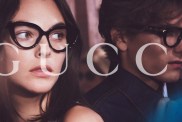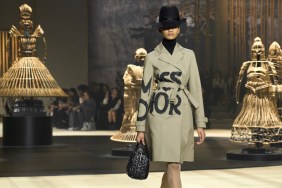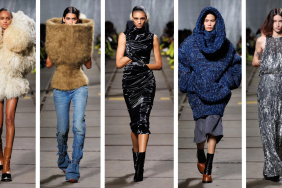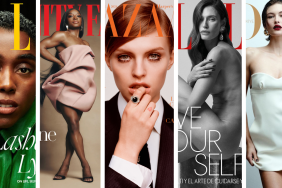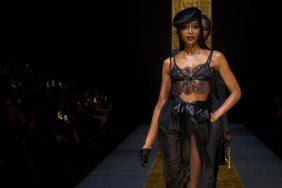Paula Hian: I started sketching and designing in diaries when I was five years old. I’m not sure where all the ideas and inspiration came from, but I often hear the same responses today when I show people the early sketches. They comment on how I seem to use the same colors and shapes as I do now…though I think the drawings I do now are better! I even wrote the same little notes or design descriptions next to each sketch. The notes were a bit more child-like, for example, writing the phrase ‘clusters of staples’ for buttons. When I started making the pieces, I would tell my mother that we needed to buy a specific plaid fabric or velvet material. She never questioned me, except she did used to ask where the ideas came from. I would tell her it was in my head and we had to do it. She listened, and that is how I began my journey.

tFS: Did she also encourage you to pursue formal training? Do you think formal training is imperative?
PH: I was an art history major at Northwestern University where I received my BA. Then I received an AAS degree from the Fashion Institute of Technology, majoring in fashion design. I think this formal training is of utmost importance, if not imperative. FIT taught me the basics, made me see clearly the direction I was headed in fashion, and really gave me the initial tools I needed to get started in the fashion industry. I believe it’s important to receive the best education possible pertaining to one’s interests and passion.
tFS: All of your pieces are made in France. Can you tell us a little bit about why?
PH: I was always interested in couture and couture details; all of my materials come from France or Italy as I travel to both countries often. I started my business working only with Italian trained patternmakers who were considered ‘master tailors’. In 2006 when I couldn’t find a replacement for an essential craftsman who had to retire, I looked toward France for this sort of worker and workmanship, and I have never looked back! They have an understanding and appreciation for quality in France that’s in their heritage. It’s a way of doing things that I understand. When it comes to the type of knitting that I do, we don’t have these facilities or technicians in the U.S.

tFS: Can you tell us a little bit about your brand and what you think makes it stand apart?
PH: My brand epitomizes luxury clothing with couture detailing that’s wearable. I am always inspired by modern or post-modern art and architecture with a feminine edge. My goal with each collection is to be forward but timeless. What makes it stand apart is how it is vertically designed — from colors to shapes, materials and styles. For the knitwear, I buy the yarn to create all of the materials and I create all of the designs in my same sketchbook. So in a sense, even if more than one is produced, the customer is receiving something original and unique as if it is one-of-a-kind or couture.
tFS: What are some of the biggest challenges running an up-and-coming fashion brand?
PH: The list is long! Seriously, running a fashion business and building a brand is a huge undertaking. Designing is a full-time job. I feel that simply working in another country is a full-time job. Production, sales, marketing, buying, going to trunk shows, daily tasks, human resources—there are so many things involved and having to manage them all while attempting to put your brand on the map is the ultimate challenge in and of itself.
tFS: With that said, were there ever moments in building your brand that you thought of giving up and if so, what made you continue?
PH: Definitely! As what I do is not an easy thing to do. I chose a ’24/7′ career and almost every day holds new challenges including technical problems, rejection and disappointments. Some of these ‘learning experiences,’ as I like to call them, have been so trying, that they have of course on occasion made me question why I do what I do. What keeps me going, however, are the customers who love or appreciate what I do – that appreciation keeps me motivated. What I do is who I am and I love it on tough days as well as good days. I have always been a person who never gives up. Ever. I try to put my quest for perfection into perspective. I may be falling asleep after the worst day and then I see a new design or inspiration pop in my head. I don’t know where they come from, but that is the sign I know to keep moving forward!
tFS: How do you deal with the day-to-day stress of running a fashion business?
PH: Since the stress is 24/7, I wish I could say that I handle it by always eating right, exercising and sleeping well, but that is not the case. I think I am just used to living with the day-to-day stress. It agrees with me — how would I deal with living without it is the question!

tFS: It seems to be working so far as your pieces have been worn by a number of celebrities. How did that come about?
PH: It was a combination of working with the right stylists and a little bit of luck! There is one stylist in particular who saw my clothing, loved it and now always borrows pieces for celebrities and editorial shoots. Other stylists also saw his favorite items when he was in Los Angeles, which made their way to more celebrities. One of the biggest surprises was when I started working in France, this same stylist sent me photos of huge billboards and buildings in New York of Taylor Momsen wearing my dress on an advertisement for the Gossip Girl. It was quite exciting! In my mind, all he did was borrow this one dress and the next thing I knew, it was plastered and painted on buildings everywhere.
tFS: Does that also help get attention for retailers? How do you go about getting your designs into stores?
PH: I work with buyers who share the same passion for quality and couture detailing that I do and who understand the hard work that goes into each collection. I have found success with many specialty stores like RGE in Rhode Island and Saks Jandel in Chevy Chase, Maryland. I design each collection with the customer in mind so it is easy to work with buyers who are familiar with that customer. Because I make the materials myself, it is also manageable to do special orders to fit a buyer’s liking.
tFS: You talk a lot about inspiration. Can you tell us more specifically where you think it comes from?
PH: I feel like it is hard to be precise about where the true inspiration really comes from. As an artist, I am definitely attracted to certain shapes, colors, textures and lines of art and architecture. The actual designs of finished pieces often appear in my head when I fall asleep or wake up — those, I can’t quite say how they arrive there.



